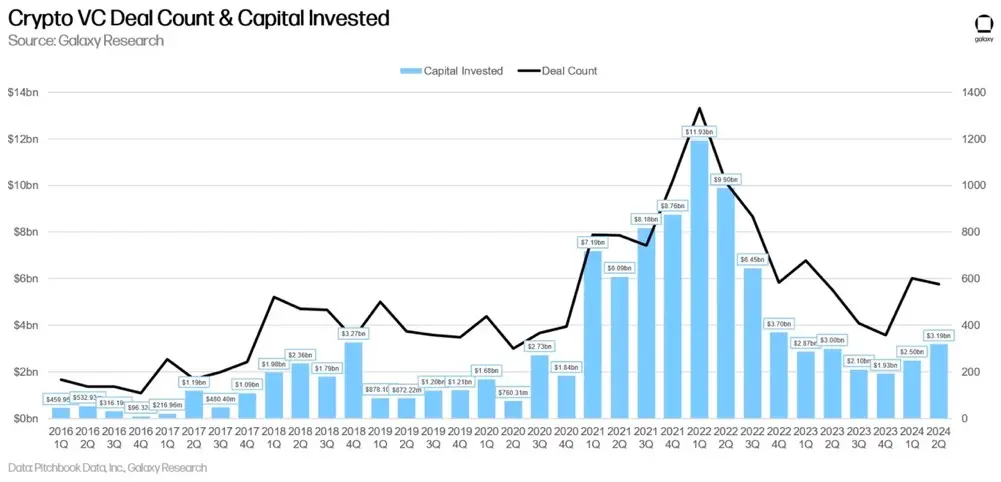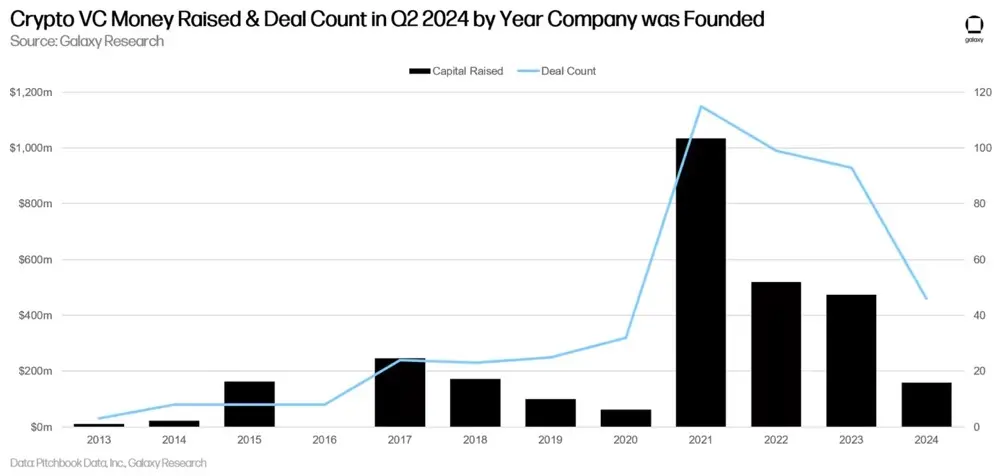Galaxy Digital Q2 Crypto Venture Capital Report: The Rebound Continues, but There is Still a Gap Compared to the Last Bull Market
Authors: Alex Thorn and Gabe Parker, Galaxy Digital Research Analysts
Compiled by: Yangz, Techub News
Compared to the strong performance of Bitcoin and liquid cryptocurrencies in the first quarter, the market slightly cooled in the second quarter, but still showed significant growth compared to the same period last year. The rebound trend in cryptocurrency venture capital that emerged in the first quarter seems to be continuing. The performance of industry founders and investors in the second quarter indicates a more active financing environment compared to previous quarters. However, as of July 1, the data performance is slightly below the general market sentiment.
The number of venture capital transactions in the second quarter slightly decreased from 603 in the first quarter to 577 in the second quarter, while investment capital increased from $2.5 billion in the first quarter to $3.2 billion in the second quarter. The median deal size increased slightly from $3 million to $3.2 million, but the median pre-money valuation rose from $19 million to $37 million, approaching historical highs. These data suggest that although available investment capital is insufficient compared to previous peaks, the recovery of the cryptocurrency market in recent quarters has led to fierce competition among investors, triggering their FOMO.
Number of Transactions and Investment Capital
In the second quarter of 2024, venture capital invested $3.194 billion in cryptocurrency and blockchain companies (a quarter-over-quarter increase of 28%), involving 577 transactions (a quarter-over-quarter decrease of 4%).

Investment Capital and Bitcoin Price
The long-term correlation between Bitcoin prices and capital invested in cryptocurrency startups has been broken. Since January 2023, Bitcoin has surged significantly, while venture capital activity has not kept pace. Although Bitcoin has risen sharply this year and invested capital has also increased, it remains far below the levels seen when Bitcoin broke $60,000 in 2021-2022. Crypto-native catalysts, such as Bitcoin ETFs and emerging fields (like re-staking, modularity, Bitcoin L2), along with pressures from bankruptcies of cryptocurrency startups and regulatory challenges, compounded by macroeconomic headwinds (interest rates), have led to this apparent divergence. Now, with the recovery of liquid cryptocurrencies, venture capitalists are preparing to return, and venture capital activity is expected to increase in the second half of this year.

Stages of Venture Capital
In the second quarter of 2024, 78% of funds were allocated to early-stage companies, while 20% were allocated to late-stage companies. Although early-stage venture capital funds focused on cryptocurrency are very active and hold reserves from 2021 and 2022, large comprehensive venture capital firms seem to have exited the industry or significantly reduced their activities, making it more difficult for late-stage startups to raise funds.

In terms of transaction numbers, the share of Pre-Seed round transactions slightly decreased but remains above the previous market cycle.

Valuations and Deal Sizes
In 2023, valuations of venture-backed cryptocurrency companies fell sharply, with the fourth quarter hitting the lowest median pre-money valuation since the fourth quarter of 2020. However, by the first quarter of 2024, valuations of venture-backed cryptocurrency companies began to rebound, soaring to $37 million in the second quarter (a quarter-over-quarter increase of 94%), reaching the highest level since the fourth quarter of 2021. It is important to note that as more data becomes available, reporting delays and the lack of public valuation data may lead to significant fluctuations in the above data. We strive to provide this information promptly after the end of each quarter, so the data may be revised, but this peak remains a signal. Additionally, the median deal size slightly increased quarter-over-quarter (+7%), reaching $3.2 million, remaining roughly stable over the past five quarters. The rise in valuations stems from improved market sentiment; although invested capital has not significantly increased, founders have seized the interest and competition among existing investors.

Investment Categories
In the second quarter of 2024, cryptocurrency companies and projects in the "Web3 / NFT / DAO / Metaverse / Gaming" category raised a total of $758 million in crypto venture capital, accounting for the largest share among all categories (24%). The two largest transactions in this category were Farcaster and Zentry, which raised $150 million and $140 million, respectively.

Following closely are companies/projects related to infrastructure, trading, and L1, with investment amounts accounting for 15%, 12%, and 12%, respectively. Notably, due to Monad and Berachain raising $225 million and $100 million, respectively, the market share of investment capital in the L1 category grew more than sixfold. Additionally, Bitcoin L2 raised $94.6 million in the second quarter of 2024, a quarter-over-quarter increase of 174% (up from $34.7 million in the first quarter).

Transaction Number by Category
In terms of transaction numbers, the "Web3 / NFT / DAO / Metaverse / Gaming" category leads with a share of 19%, primarily due to the increase in decentralized social media and gaming-related transactions. Although the number of cryptocurrency startups raising funds related to re-staking decreased in the second quarter of 2024, the number of transactions in the infrastructure category ranked second this quarter, accounting for 15%.

Following closely are cryptocurrency companies/projects related to trading and DeFi, accounting for 11% and 9% of the total number of transactions completed in the second quarter of 2024, respectively.

Venture Capital Stages and Category Breakdown
By breaking down investment capital and transaction numbers by stage and category, we can gain a clearer understanding of which types of companies are raising funds in each category. In the second quarter of 2024, the vast majority of funds in the Web3, L1, and infrastructure categories were directed towards early-stage companies and projects, while venture capital in the trading category was more focused on late-stage companies.

By studying the share of capital invested in each category at various stages, we can gain insights into the maturity of investable capital across different categories.

Additionally, the number of transactions also reflects a similar situation. A significant portion of completed transactions across almost all categories involved early-stage companies and projects.

By examining the share of completed transactions at each stage within each category, we can gain deeper insights into the various stages of each investable category.

Geographic Breakdown of Investments
In terms of investment numbers, in the second quarter of 2024, over 40% of venture capital was directed towards companies headquartered in the United States. The UK accounted for 10%, Singapore for 8.7%, the UAE for 3.13%, and Hong Kong for 2.78%.

In terms of investment amounts, companies headquartered in the United States attracted 53% of venture capital, a quarter-over-quarter increase of 23.5%. The UK accounted for 12.78%, Singapore for 4.6%, and the UAE for 4.39%.

Group Breakdown of Investments
The vast majority of venture capital in the second quarter of 2024 was directed towards companies established between 2021 and 2023.

Conclusion
Sentiment in crypto venture capital continues to improve, but levels remain significantly lower than during the bull markets of 2021-2022. With Bitcoin and Ethereum rising about 50% this year, investment capital increased by 28% quarter-over-quarter, while the number of transactions remained roughly stable. If this growth rate continues until the end of the year, the investment capital and transaction numbers for 2024 will rank third, following 2021 and 2022.
Investments in the Web3 and L1 categories are particularly noteworthy. Driven by Farcaster ($150 million) and Zentry ($140 million), the Web3 category leads with approximately $750 million in total funding. Meanwhile, L1 ranks fourth with $371 million, propelled by transactions involving Monad ($225 million) and Berachain ($100 million).
The median valuation of cryptocurrency companies receiving venture capital has surged significantly, reaching the highest level since the fourth quarter of 2021 (the peak of the last bull market). Affected by the bear market of 2022 and adverse macroeconomic factors, most traditional venture capital firms remain on the sidelines, while crypto-focused venture capital firms are in a more competitive environment, providing founders with more negotiating power. It is important to note that this median is based on available data as of July 1, and as more transaction information from the second quarter becomes available, the median may be updated and potentially adjusted downward.
Bitcoin L2 continues to attract significant investment, with related companies and projects raising a total of $94.6 million, a quarter-over-quarter increase of 174%. Investors remain enthusiastic about the potential for more composable block space in the Bitcoin ecosystem, attracting models like DeFi and NFTs back to the ecosystem. Our internal research indicates that at least 65 projects claim to be "Bitcoin L2."
Early-stage transactions dominated in the second quarter, capturing nearly 80% of investment capital, with Pre-Seed round transactions accounting for 13% of all transactions. The sustained focus on early-stage transactions suggests a long-term healthy development of the broader cryptocurrency ecosystem. While some late-stage companies are struggling to raise funds, entrepreneurs are seeking investors willing to invest in new innovative ideas.
The United States continues to dominate the cryptocurrency startup ecosystem. While the U.S. maintains a significant lead in transactions and capital, adverse regulatory factors may force more companies to relocate to other countries and regions. If the U.S. wants to maintain its position as a long-term center for technological and financial innovation, policymakers need to recognize how their actions or inactions will impact the cryptocurrency and blockchain ecosystem.









